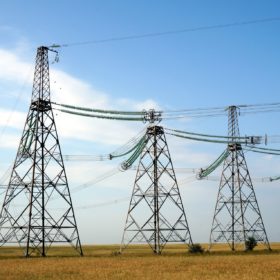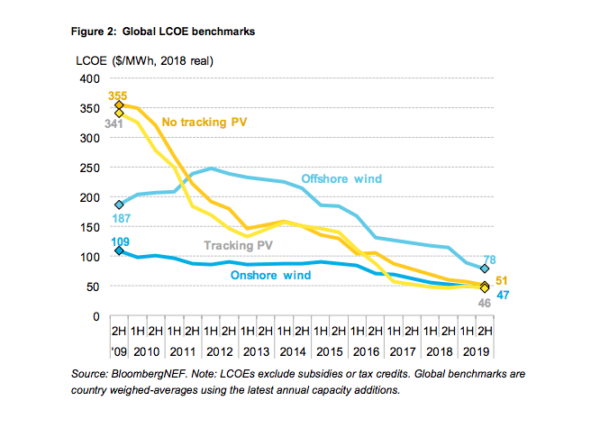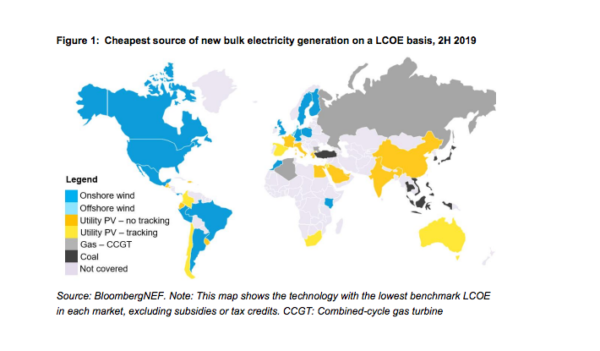
The latest figures released by BloombergNEF show new solar and onshore wind power plants have reached parity with average wholesale prices in California, China and parts of Europe. The technologies are winning the race to be the cheapest sources of new generation for two-thirds of the world’s population.
The levelized cost of energy (LCOE) for solar and wind power continues to decline and has already reached parity with wholesale power prices in California, China and parts of Europe, according to the latest report from business intelligence company BloombergNEF (BNEF).
The report illustrates ‘grid parity’ has already been reached in some of the world’s biggest markets as others strive towards the same goal.
According to BNEF’s global benchmark, the cost of electricity produced by solar and onshore wind projects stands at $51 and $47/MWh, respectively – down 11% for solar and 6% for onshore wind from six months ago. Cheaper equipment costs are the main driver behind the latest price falls. The offshore wind LCOE benchmark sits at $78/MWh, down 32% from last year.

BNEF analysts estimate some of the cheapest solar projects financed recently will be able to achieve an LCOE of $27-36/MWh, assuming competitive returns for equity investors are factored in. Such generation facilities can be found in India, Chile and Australia.

China’s grid parity push
In China, the capital expenditure for utility scale PV plants has fallen 11% in six months, to hit $570,000 per megawatt, BNEF reported. The study’s authors say the downturn in Chinese installations since Beijing announced an intent to cut back public solar subsidies at the end of May last year has left developers and engineering, procurement and construction services providers scrambling for business, with an inevitable downward pressure on capital expenditure costs. In the first six months of the year, China deployed only around 11 GW of new PV generation capacity and hopes for an end-of-year rally increasingly appear to have been misplaced.
Meanwhile, the country’s grid-parity solar push has intensified. Under the nation’s new solar policy, the world’s biggest PV market removed limits on non centrally-subsidized PV projects across 12 provinces and parts of three others. The authorities have revealed details of almost 15 GW of ‘grid parity’ projects already, albeit not expected to come online until 2020-23.
The grid parity projects are not entirely free of public support as land use fees have been reduced or waived in several instances. Grid operators have also been ordered to offer priority dispatch for power generated by grid-parity projects; to ensure electricity off-takers for such power; and to offer fixed-payment power purchase agreements of at least 20 years’ duration.
Three-stage process
Average electricity prices for energy generated by new solar and onshore wind plants have reached parity with average wholesale prices in California and parts of Europe, claim the BNEF analysts. In China, the levelized cost of such energy is now below the average regulated coal power price, the reference price tag in the country.
“This is a three-stage process,” said Tifenn Brandily, an associate in BNEF’s energy economics team and the report’s author. He said phase one concerned the electricity generated by new solar and wind projects becoming cheaper than that produced by new coal and gas plants. In phase two, renewable energy reaches parity with power generated by legacy fossil fuel plants and in phase three, clean energy becomes cheaper than that produced by existing thermal plants. “Our analysis shows that phase one has now been reached for two-thirds of the global population,” said Brandly. “Phase two started with California, China and parts of Europe. We expect phase three to be reached on a global scale by 2030.”
Analysis produced by Bermuda-based asset management company Lazard last year demonstrated building new solar and wind plants is in some cases already cheaper than running existing fossil fuel and nuclear facilities.
Lắp đặt điện mặt trời Khải Minh Tech
https://ift.tt/2X7bF6x
0906633505
info.khaiminhtech@gmail.com
80/39 Trần Quang Diệu, Phường 14, Quận 3
Lắp đặt điện mặt trời Khải Minh Tech
https://ift.tt/2ZH4TRU
Không có nhận xét nào:
Đăng nhận xét